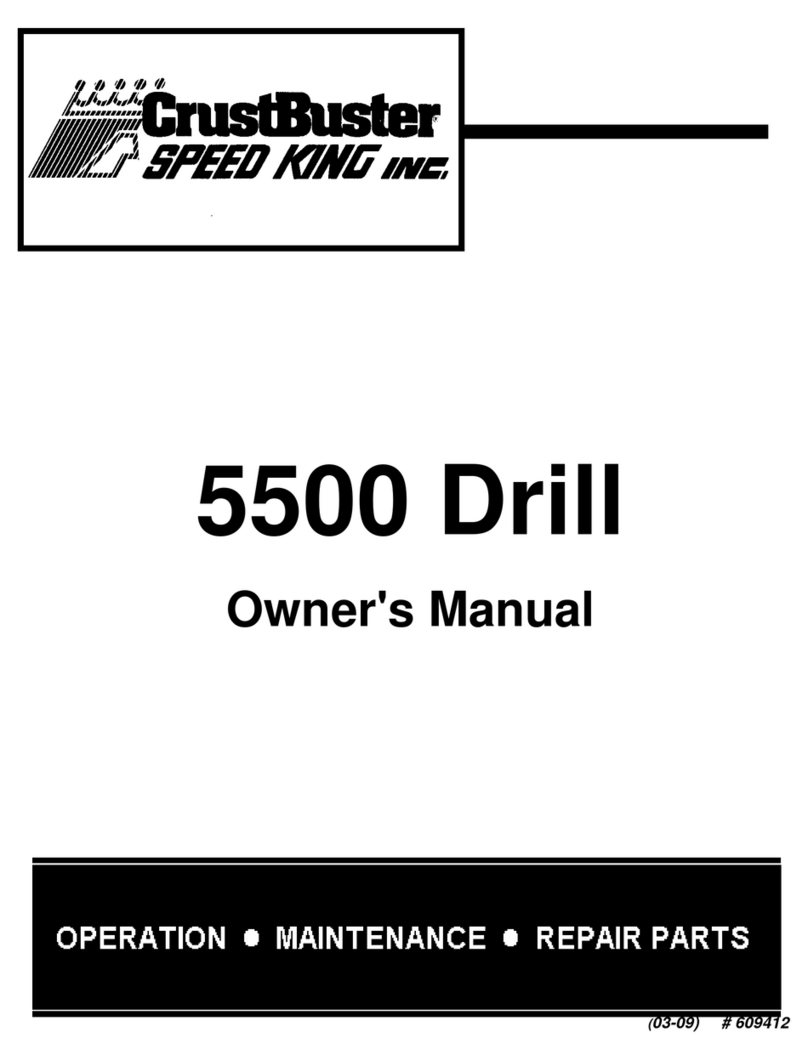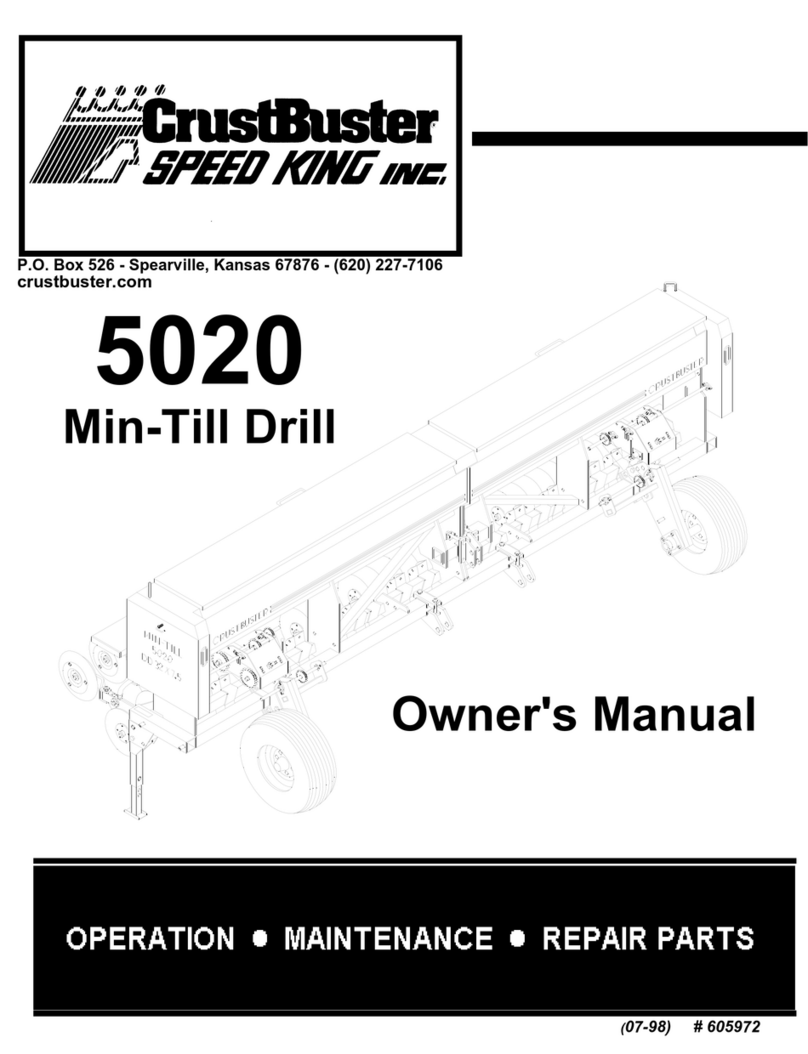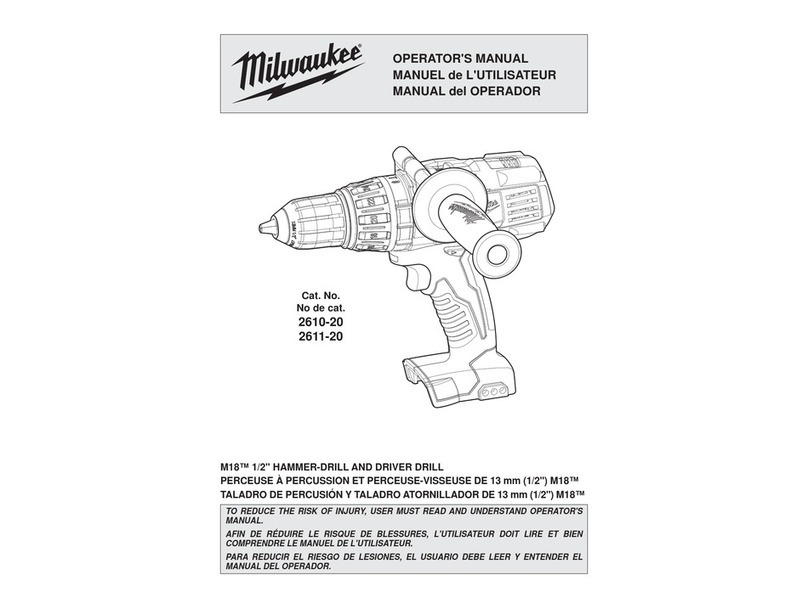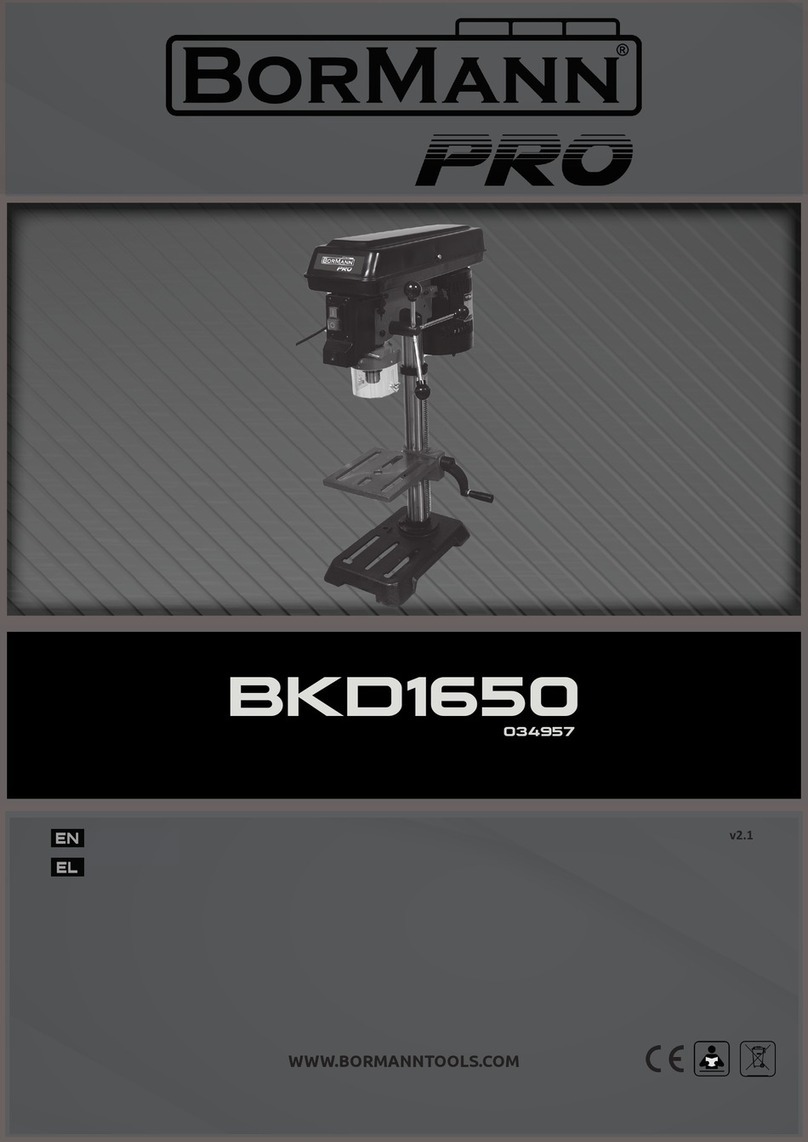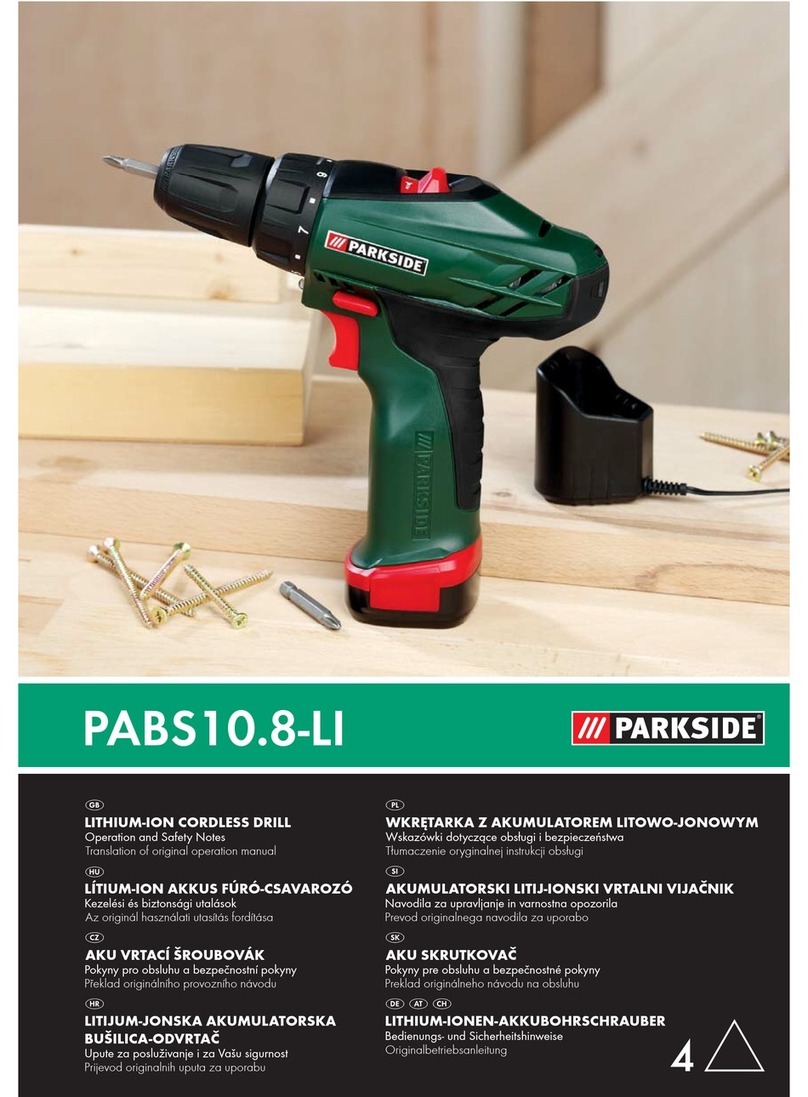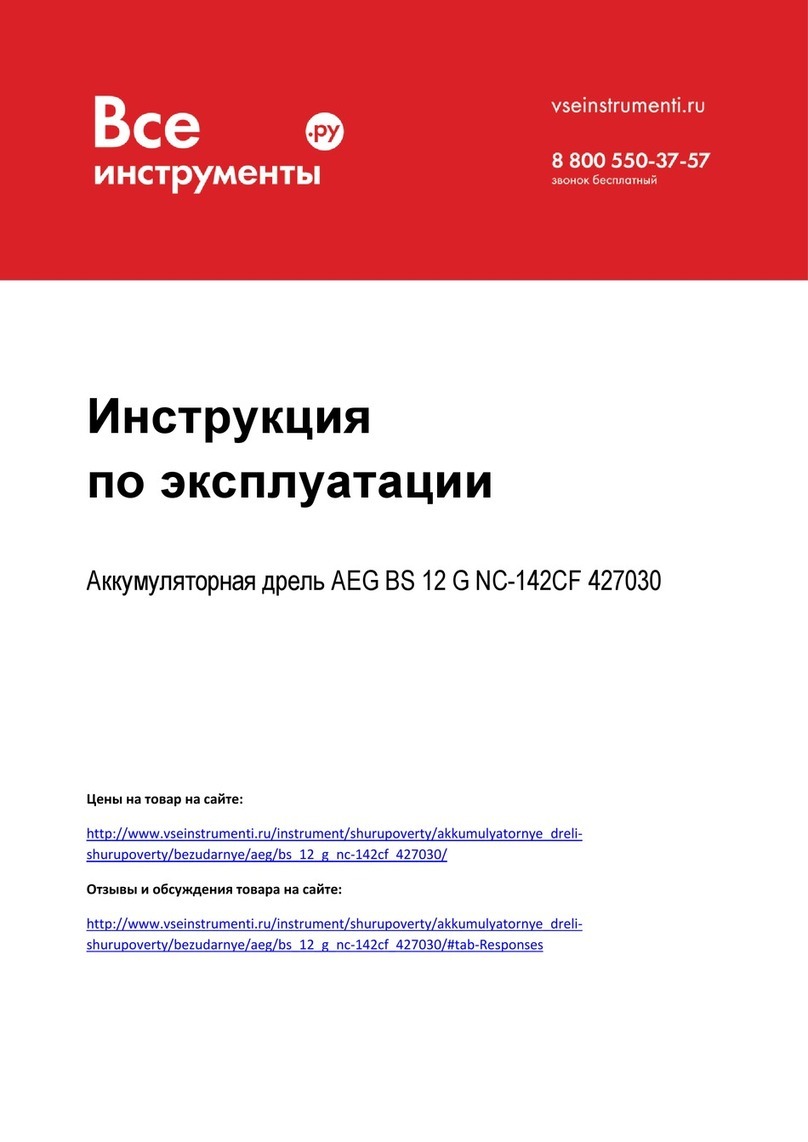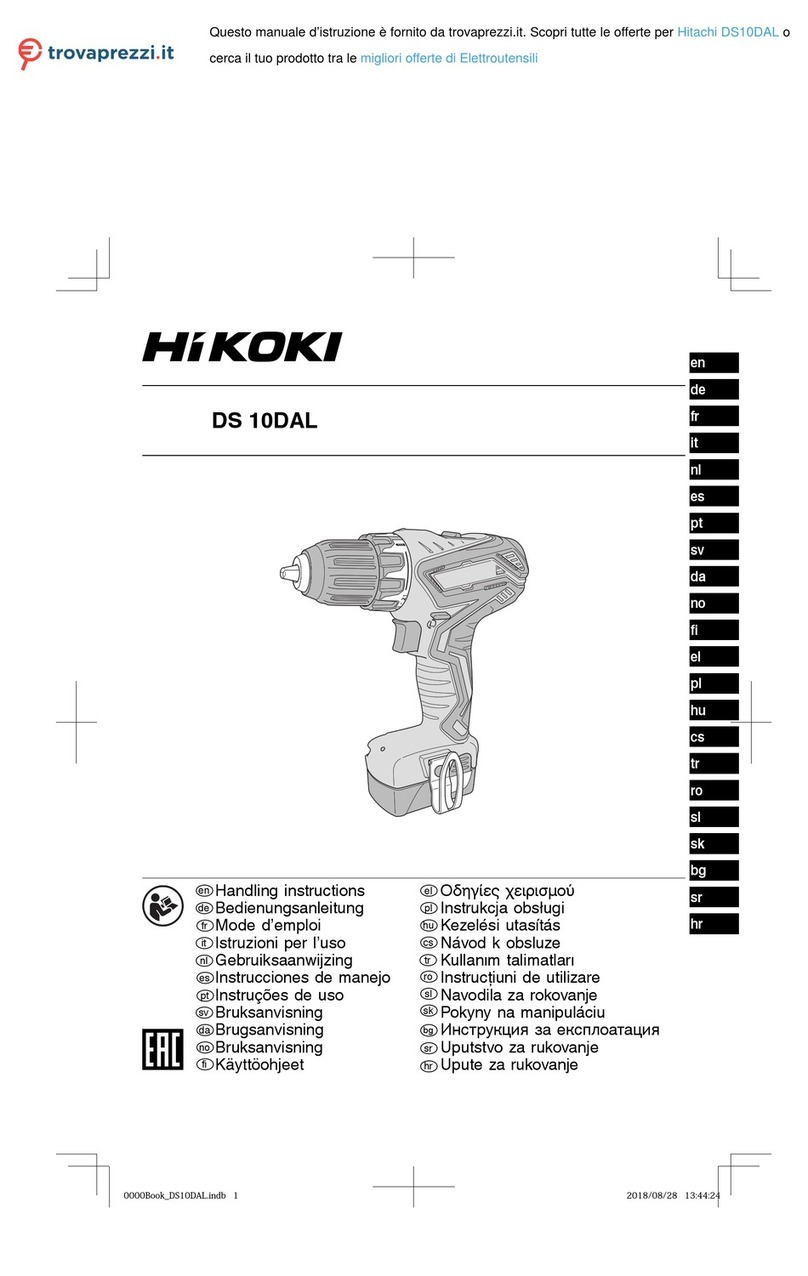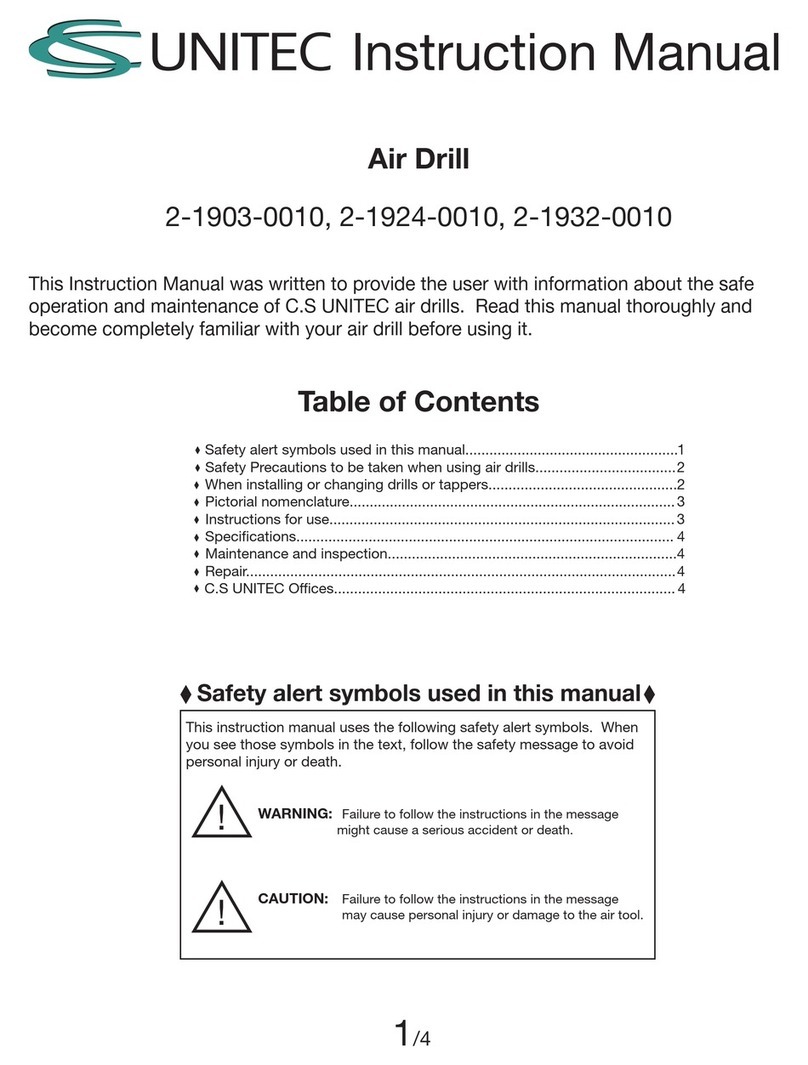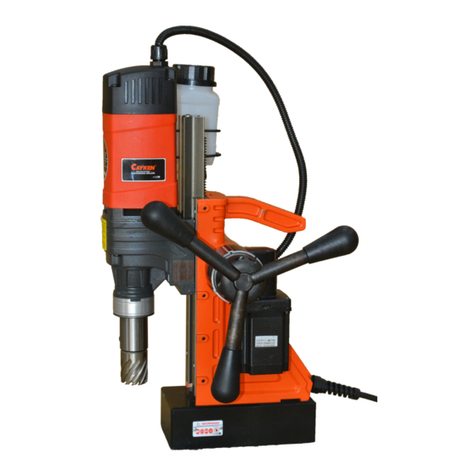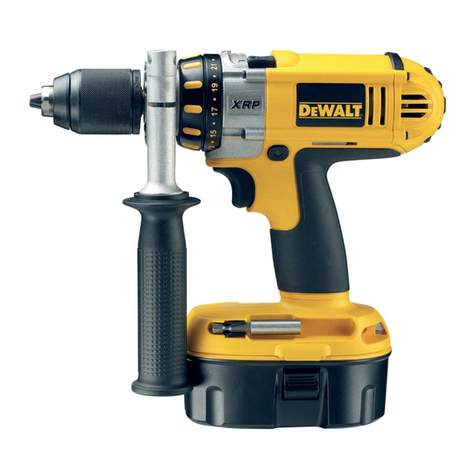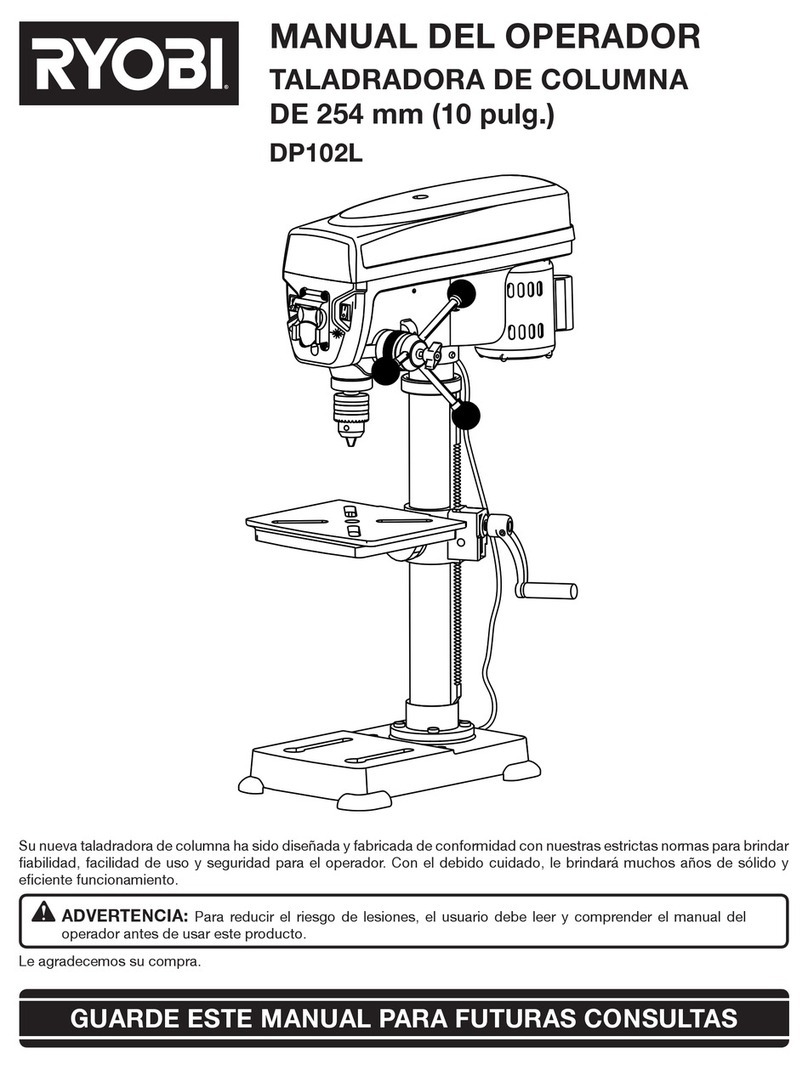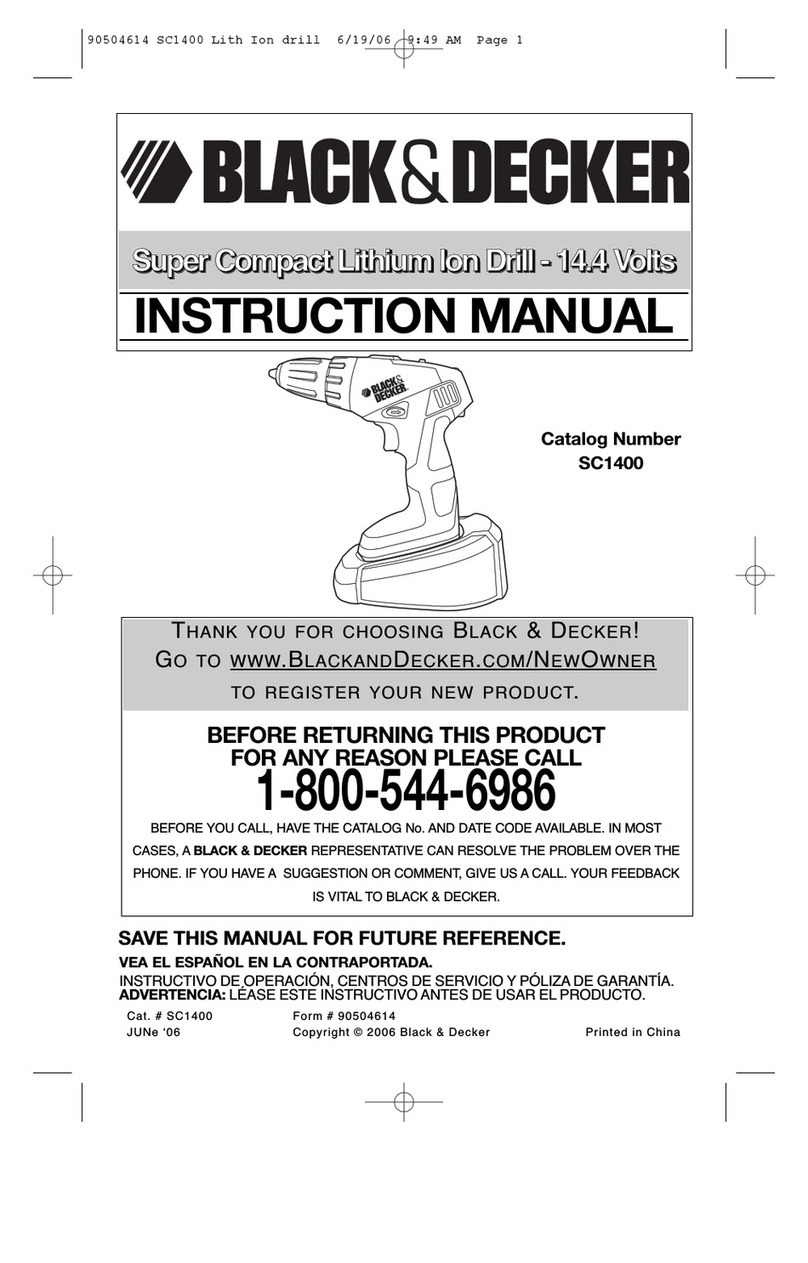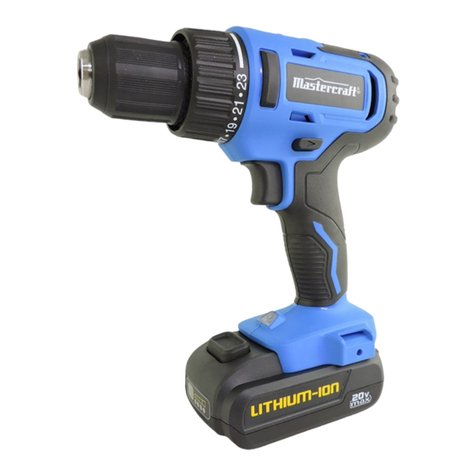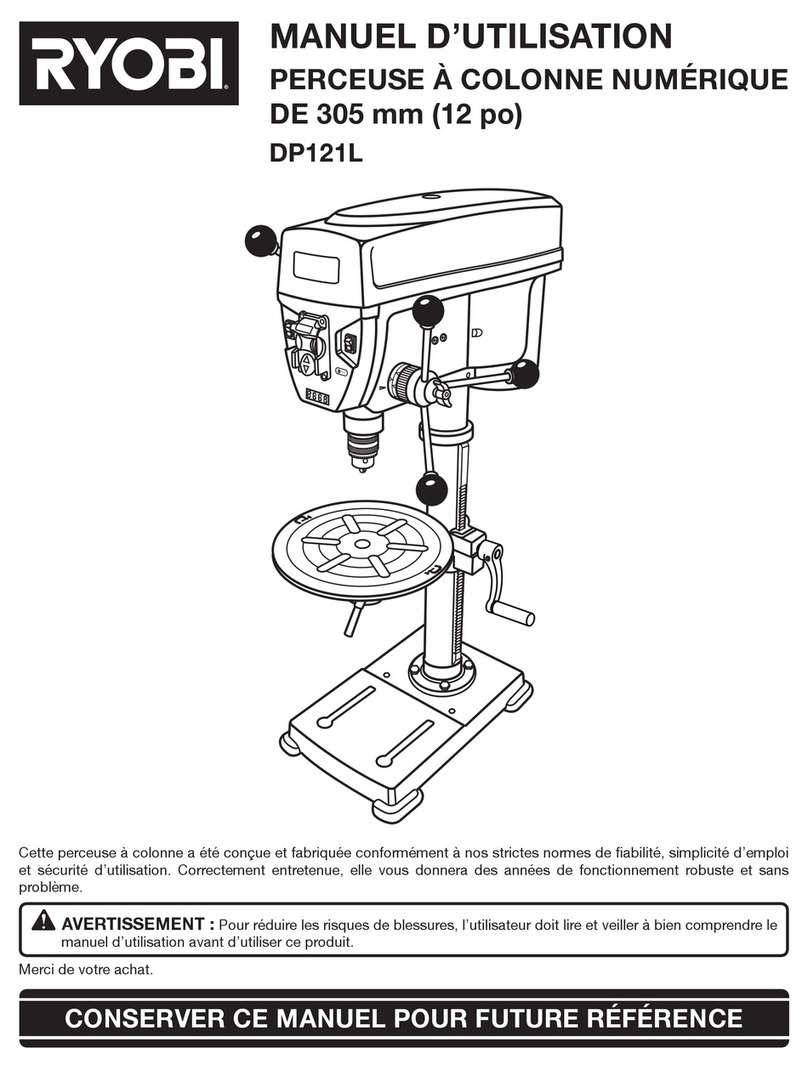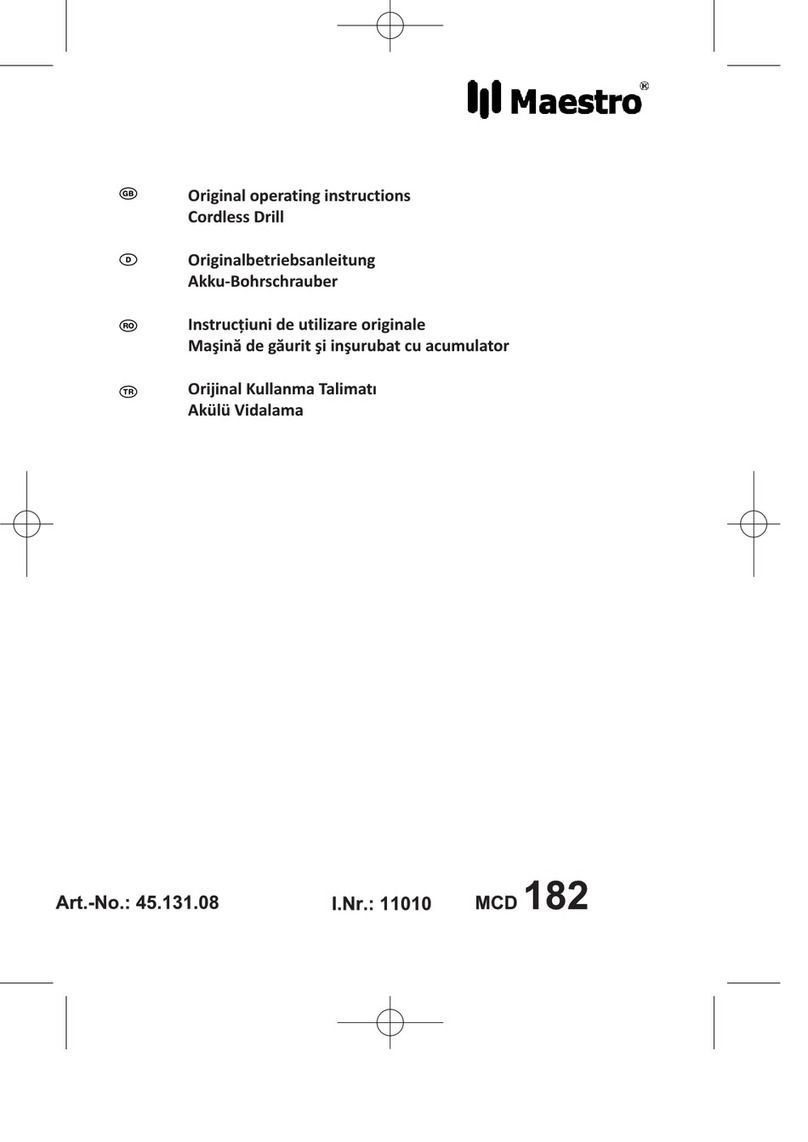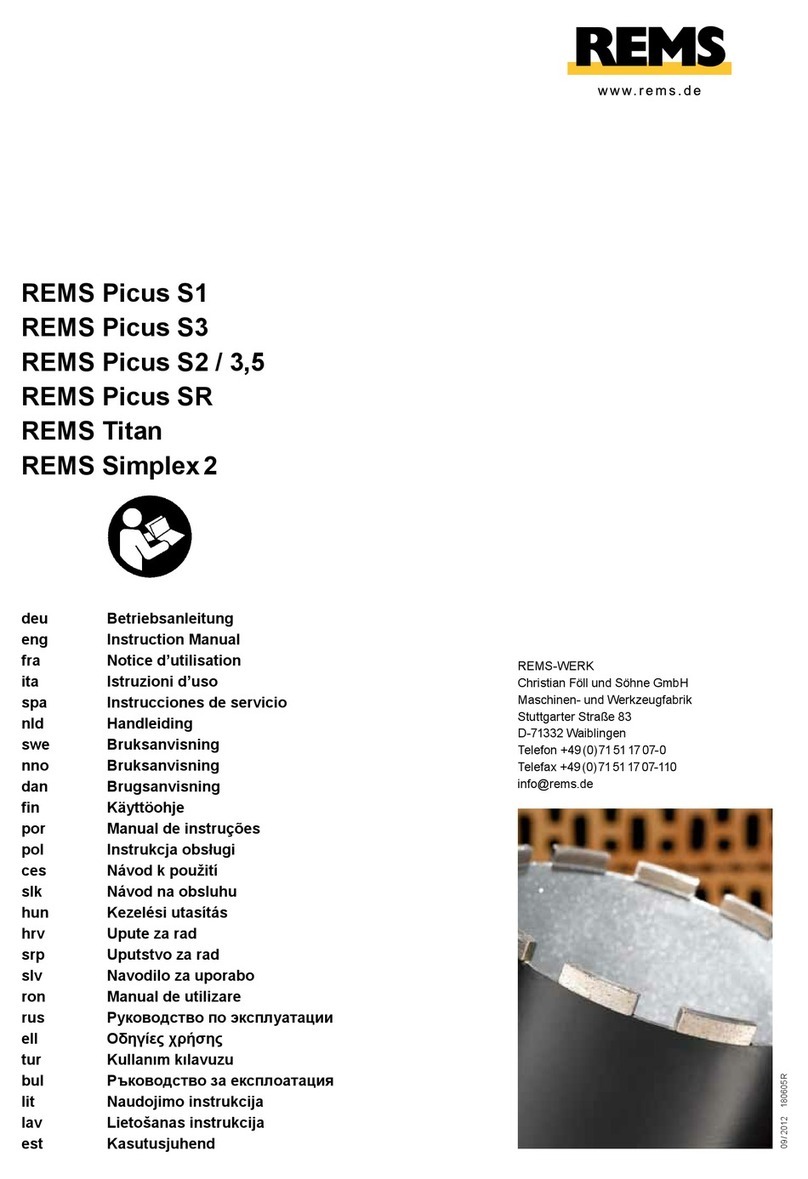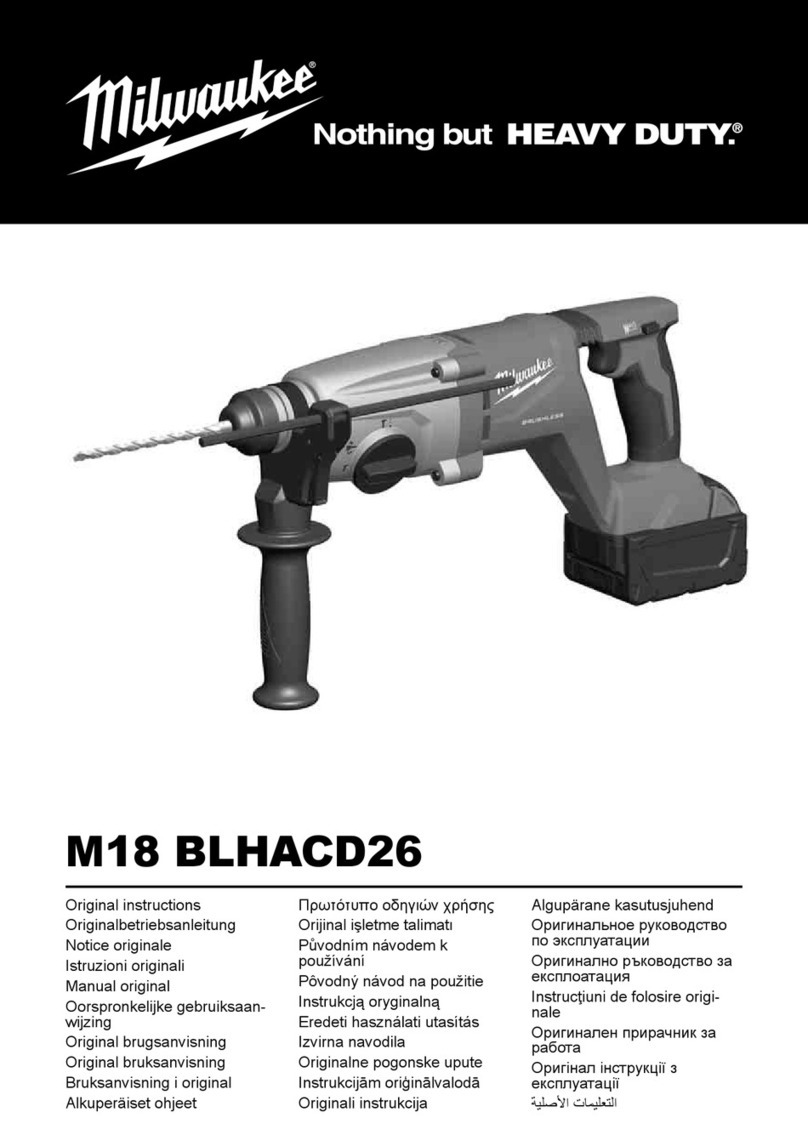CrustBuster 4600 Series User manual

4600 SERIES
ALL PLANT DRILL
P.O. Box 526 - Spearville, Kansas 67876 - (620) 227-7106
(2009) #605717

Identification
Your CrustBuster® drill is identified by a Serial Number and Model Number. Record these
numbers in the spaces provided in this manual and refer to them when ordering parts or requesting
service.
Serial Number Model Number
Warranty
WARRANTY: In addition to the implied warranties of fitness and of merchantability,
CrustBuster®/Speed King, Inc. warrants new products sold by it to be free from defects in
workmanship and material for a period of 12 months, from the date of delivery to the first user
customer. Warranty on purchased parts (cylinder, blades, bearings, shanks, etc.) will be the
same as that offered by the appropriate manufacturer of these parts.
EXCLUSIONS: No warranty of any kind is made by CrustBuster®/Speed King, Inc. with regard
to new products which have been subject to operation in excess of recommended capacities,
misuse, abuse, negligence, or accident, or have been altered or repaired in any manner not
authorized by CrustBuster®/Speed King, Inc. CrustBuster®/Speed King, Inc. is constantly
striving to improve its products. Changes in design and improvement will be made whenever
CrustBuster®/Speed King, Inc. believes the efficiency of its products will be improved thereby,
but without incurring any obligation to incorporate such improvements in any products which
have been shipped or are in service. No obligation exists for compensation of unauthorized
repairs or modifications without prior approval. And in no event will CrustBuster®/Speed King,
Inc. be liable for consequential damages, such as but not limited to: downtime, delayed or late
tillage or planting, etc.
WARRANTY REGISTRATION: This warranty is not valid unless registered with
CrustBuster®/Speed King, Inc. within 10 days from the date of purchase. It is the sole
responsibility of the selling retail dealer to fill out the registration forms and see that they are
properly filed with CrustBuster®/Speed King, Inc.
WARRANTY PROCEDURE: Should any part fail to conform with this warranty,
CrustBuster®/Speed King, Inc. will repair or replace the part or parts which do not conform.
If a part is defective, take it to your authorized CrustBuster® Farm Equipment Dealer
immediately, along with your warranty registration, and complete the proper forms requesting
a warranty adjustment. Our representative will pick up the part to be returned to the factory
for examination. If the customer (first user) requests that a new part be substituted for the old
part, a new part will be charged to the dealer who will in turn charge the customer. If the part
is found by us to be defective, a credit for the part will be given to the dealer to be passed on
to the customer. If the dealer or customer wishes to repair the part, this will be done only if
authorized by CrustBuster®/Speed King, Inc. This warranty procedure is in addition to all
remedies authorized by law.
CRUSTBUSTER®/SPEED KING, INC.
Box 526
Spearville, KS 67876
Specifications are subject to change without notice. ® is a registered trademark of CrustBuster/Speed King, Inc.

Table of Contents
Safety Instructions.. . . . . . . . . . . . . . . . 2-6
Dimensions & Specifications. . . . . . . . . . . 7
Field Operation:
Operating Speed. . . . . . . . . . . . . . . . . 8
Adjustment Procedure. . . . . . . . . . . . . 8
Leveling Drill. . . . . . . . . . . . . . . . . . . . 8
Toolbar Adjustment. . . . . . . . . . . . . . . 8
Setting Down Pressure. . . . . . . . . . 8-9
Setting Seed Depth. . . . . . . . . . . . . . . 9
Conventional Field Conditions. . . . . . 10
Minimum Tillage Conditions.. . . . . . . 10
No-Till Conditions.. . . . . . . . . . . . . . . 10
Calibration / Drilling Rates.. . . . . . . . . . . 11
Sprocket Box Operation. . . . . . . . . . . . . 11
Lubrication and Service.. . . . . . . . . . . . . 12
Scraper Adjustment.. . . . . . . . . . . . . . . . 13
Blade Gap Adjustment. . . . . . . . . . . . . . 13
Tandem Wheel Drive Clutch. . . . . . . . . . 13
Wobble Slot Seed Cup
Adjustments / Service. . . . . . . . . 14-15
Meter Man Acreage Counter. . . . . . . . . . 16
Sprocket Box Adjustments
& Locations. . . . . . . . . . . . . . . . . . . . 17
Seed Rate Charts. . . . . . . . . . . . . . . 18-25
Legume Box Charts. . . . . . . . . . . . . . 25
Small Seed Sprocket Locations. . . . . 26
Small Seed Charts. . . . . . . . . . . . . . . 27
Native Grass Sprocket Locations.. . . 28
Illustrations and Repair Parts:
Hitch.......................... 29
Main Frame. . . . . . . . . . . . . . . . . 30-32
Top Frame. . . . . . . . . . . . . . . . . . 32-33
Grain Box.. . . . . . . . . . . . . . . . . . 34-41
10' Drive.. . . . . . . . . . . . . . . . . . . . . . 42
13' Drive.. . . . . . . . . . . . . . . . . . . . . . 43
15' Drive.. . . . . . . . . . . . . . . . . . . 44-45
Clutch Assembly. . . . . . . . . . . . . . . . 45
20' Drive.. . . . . . . . . . . . . . . . . . . 46-47
Wheel Idler Assembly. . . . . . . . . . . . 47
All Plant Opener Assembly. . . . . 48-49
Gear Box Assembly. . . . . . . . . . . 50-55
Clutch Lever Assembly. . . . . . . . . . . 56
Drive Clutch Sprocket. . . . . . . . . 56-57
Hydraulic Layout. . . . . . . . . . . . . . . . 57
Spindle & Hub Assembly. . . . . . . . . . 58
6 Bolt Hub & 8 Bolt Hub. . . . . . . . . . . 58
Cover Shield Assembly. . . . . . . . . . . 59
Presswheel Arm Assemblies. . . . 60-61
Presswheel Assemblies. . . . . . . . 62-63
Feed Tube Assembly.. . . . . . . . . . . . 63
Marker..................... 64-65
Harrow..................... 66-70
10'-13'-15' Legume Box Assembly.72-73
10'-13'-15' Legume Box Drive. . . 74-75
15' Legume Box Assembly.. . . . . 76-77
20' Legume Box Assembly.. . . . . 78-79
Cylinders. ..................... 80
Lights......................... 81
Fertilizer
Settings, Cleaning, Storage. . . . . 84-85
Sprocket Locations. . . . . . . . . . . . . . 86
Delivery Rate Chart. . . . . . . . . . . . . . 87
Drive Assembly. . . . . . . . . . . . . . 88-89
GearBox................... 90-91
Box Bottom. . . . . . . . . . . . . . . . . 92-93
Drive Clutch. . . . . . . . . . . . . . . . . . . . 93
FeedTubes.................... 94
Troubleshooting. . . . . . . . . . . . . . . . . . . 95
1

BE A SAFE OPERATOR
BY THINKING BEFORE ACTING
AND
BY READING
YOUR OWNER'S MANUAL
Avoid Accidents
Most accidents, whether they occur in
industry, on the farm, at home, or on the
highway, are caused by the failure of some
individual to follow simple and fundamental
safety rules or precautions. For this reason
most accidents can be prevented by
recognizing the real cause and doing
something about it before the accident
occurs.
———————
Regardless of the care used in the design
and construction of any type of equipment,
there are many conditions that cannot be
completely safeguarded against without
interfering with reasonable accessibility and
efficient operation.
A CAREFUL OPERATOR
is the Best Insurance Against an
Accident.
The complete observance of one simple
rule would prevent many thousands
of serious injuries each year.
That rule is:
Never Attempt to
Clean, Oil, or Adjust
A Machine While It Is In Motion.
To Our Customers
The following pages and illustrations are
printed to help supply you with the knowledge
to better operate and service your new
CrustBuster equipment.
We are proud to have you as a customer
and feel you will be proud to be a
CrustBuster owner.
Any piece of equipment needs, and must
have, a certain amount of service and
maintenance to keep it in top running
condition. We have attempted to cover all
the adjustments required to fit most
conditions; however, there may be times
when special care must be taken to fit a
condition.
Study this owner's manual carefully and
become acquainted with all the adjustments
and operating procedures before attempting
to operate your new equipment. Remember,
it is a machine and has been designed and
tested to do an efficient job in most operating
conditions and will perform in relation to the
services it receives.
If special attention is required for some
condition, ask your CrustBuster dealer; he
will be glad to help and answer any questions
on operations and service of your new
machine.
TAKE TIME FOR SAFETY
2

Before Operating This Equipment
Read and understand this owner's manual.
Safety & Set-Up Instructions
FIf your drill is delivered with a shipping bracket, DO NOT install hitch or operate
hydraulics until bracket is completely removed. Damage to drill will result.
FDealer Installation of Hitch - Be sure hitch bolts are torqued equally. DO NOT tighten
one side completely before the other. Failure to follow these instructions could cause
hitch to be off center and drill will not run straight.
FSecure implement to tractor drawbar using as large a hitch pin as will allow. A large
bolt with locking nut or castle nut is recommended. DO NOT use a hairpin or wire to
secure hitch pin. Residue may catch and remove these devices. ALWAYS SECURE
DRILL TO TRACTOR USING THE SUPPLIED SAFETY CHAIN.
FMake sure 3-point linkages are raised completely to clear hitch.
FDO NOT attempt to remove the hydraulic cylinder unless you have taken the
precautions described on page 4 of this manual. Serious injury or death could
occur if the correct procedure is not followed!
FIf your tractor does not already have a lighting receptacle, install one. Always plug in
the drill lighting system to a correctly wired tractor and USE for transport safety.
FYour drill may weigh more than the towing vehicle. The drill is not equipped with
brakes. EXERCISE EXTREME CAUTION ! Maximum allowable speed - 25 mph.
FIf your drill is equipped with hydraulic markers, always attach safety chains before
transporting.
FAlways install transport lock to hydraulic cylinder before transporting.
FRemove transport lock from lift cylinder before attempting field operation.
FNever have more than 391 lbs. per section on the walkboards without drill securely
attached to tractor or towing vehicle.
FCheck lug nuts or bolts. Torque to 100 ft. lbs. after approximately one mile and
periodically after.
FAfter approximately 10 hours, make sure tool bar bolts, wheel bolts, presswheel bolts,
etc. are tight. Check tool bar bolts every 10 to 15 hours. Tool bar bolts must stay
tight. Failure to comply could cause damage to tool bar and main frame in the form
of egg shaped holes.
FNEVER ALLOW ANYONE TO RIDE THE DRILL!
3

Safety Instructions
4

Safety Instructions
5

DANGER: Indicates an imminently hazardous situation
which, if not avoided, will result in death or serious injury.
WARNING: Indicates a hazardous situation which, if not
avoided, could result in death or serious injury.
CAUTION: Indicates a potentially hazardous situation
which, if not avoided, may result in minor or
moderate injury.
NOTICE: Used to address practices not related to
physical injury.
Field Operating Checklist
____ Inflate tires to recommended air pressure.
____ Lubrication as required.
____ Seed shafts turned manually to check for obstructions and improper chain alignment on drive
sprockets.
____ Correct sprocket selection and slot width for seed type and siz
____ Calibration as required for accuracy.
____ Drill adjusted at hitch for level field operation.
____ Cylinder stop set for proper toolbar rotation.
____ Down pressure set for soil conditions.
____ Acre meter reset.
____ Lower drill while moving forward to avoid plugging openers.
____ Check seed depth and adjust accordingly.
____ Allow no riders.
____ After approximately 10 hours, check tool bar bolts, wheel bolts, presswheel swivel bolts, etc..
Make sure they are tight.
Transport Instructions
FBefore attempting to operate the lift cylinder, remove transport lock. Store cylinder lock on the
holder attached to the front of the weight bar bracket. When traveling long distances, it is
recommended that the transport lock be installed, pressure relieved from the hydraulic hoses
and hoses hooked to the tractor. If trailing behind a towing vehicle, the hydraulic hoses should
be stored in the slotted storage in the tongue cover.
FNEVER use an unsecured pin in draw bar.
FDO NOT attempt to remove the cylinder at any time for transport or field operations.
FStow the adjustable jack on top of the tongue mounting stub to avoid interference with main
tractor wheels in tight turns and make sure 3-pt linkages are fully raised.
FConnect the 7 pin lighting plug to the tractor receptacle and use at all times. Confirm the
correct lights are operating if your tractor is not wired by industry standard code. Standard 7
pin receptacles are available through your dealer, local truck supply stores, and auto parts
facilities.
FAlways attach the safety chain to the tractor drawbar system.
FDisconnect drive chain and store on the "dummy" sprocket when traveling long distances.
FIf your drill is equipped with hydraulic markers, the safety chains should be attached to the
marker to avoid catastrophic injury to oncoming vehicles.
FMaximum allowable speed; 25 mph.
CAUTION! Your drill may weigh more than the towing vehicle. The drill is NOT
equipped with brakes. Exercise extreme caution!
6

TRANSPORT LENGTH
TRANSPORT WIDTH
T
R
A H
N E
S I
P G
O H
R T
T
Dimensions & Specifications
10', 15' & 20' Drill Weights
Presswheels
Size
&
Spacing
Number
of
Openers
Single
2 x 13
Flat
Single
2 x 13
Peaked
Single
3 x 13
Single
3 x 13
Center Rib
Single
3 x 14
V-Type
10' x 7½" 16 NA NA NA
10' x 10" 12 NA NA NA
15' x 7½" 24 7600 7672 7936
15' x 8" 22 7420 7486 7728
15' x 10" 18 6890 6950 7144
20' x 7½" 32 8690 8784 9200
20' x 8" 30 8515 8574 8964
20' x 10" 24 7920 7943 8255
7

Field Operation
Recommended Operating Speed
Operating speeds of 4-7 mph will provide
optimum results from your All Plant drill.
Conventional field conditions can warrant
speeds in the upper end of the range. High
levels of "tough" residue due to morning dew or
recent moisture, rough field conditions, rocky
fields, or hard ground may require lower
speeds for adequate performance.
Recommended Adjustment Procedure
Setting your All Plant drill requires adjustments
be made in a particular order to ensure the
opener will work properly. You will find it much
easier to set the drill if adjustments are made in
the following order:
1. Level the drill
2. Set toolbar rotation
3. Set down pressure
4. Set seed depth
Leveling the Drill
It is important to level the drill from front to back
first. The tongue and box should be as close to
level as you can get it by changing the drawbar
height on the tractor (on offset drawbars), or by
repositioning the clevis or mono hitch mounting.
Any time a different tractor is hooked to the drill
you should recheck level.
Clevis Positions
Toolbar Adjustment
After the drill is leveled, rotation of the toolbar
must be set. Using the screw adjustable stop
on the lift cylinder, adjust rotation of the toolbar
until the 2" x 4" tubing the openers are mounted
on is perpendicular to the ground. Adjustment
range of the presswheel depth quadrant will be
affected if the toolbar does not rotate far
enough or goes beyond perpendicular. If the
toolbar is not set correctly, the opener travel
range will not allow for penetration into low
areas or provide clearance when meeting
obstructions.
Setting Down Pressure
The parallel linkage opener design assures the
operator the opener blades and presswheel
operate on the same level throughout the range
of up and down travel. Due to the location of
the down pressure spring, the pressure applied
to the opener remains relatively constant in the
entire range of travel. Changing the spring
position from the first (top) notch to the last
(bottom) notch provides 5 different levels of
force. Each notch represents approximately
these amounts of down pressure:
1 2
Spring Springs
Notch 1 (top) 120# 200#
Notch 2 160# 260#
Notch 3 200# 330#
Notch 4 240# 400#
Notch 5 260# 500#
8

Field Operation
Setting Down Pressure - (cont.)
It may be necessary to add ballast to the drill in
the third or fourth notch. In order that all the
opener springs are able to achieve the down
pressure selected, the total weight of the drill
must equal that amount of pressure times the
number of row units on the drill. The parallel
linkage arms should have a "live working
action" during field operation. Setting the drill
for too much down pressure without adequate
weight will reduce the ability of the opener to
flex and give good performance.
To determine the correct amount of down
pressure, begin with the unit set in the lightest
setting and the presswheel adjusted all the way
up (or deepest setting). Put the openers in the
ground and pull forward 50-100 feet. Stop and
check opener penetration. If the opener is not
penetrating to the depth you wish to plant,
rotate toolbar upwards until clear of the ground,
and add one more notch of down pressure.
Repeat the process until the opener will
penetrate to at least the depth you wish to
plant.
Setting Seed Depth
Depth settings are achieved by moving the
depth quadrant to effect the presswheel
relationship to the opener. Changes are made
by releasing the spring-loaded lock handle and
moving the quadrant up or down with the hand
slot. LOWERING the quadrant will set seed
depth shallow --RAISING the quadrant will set
seed depth deeper. Irregular seed placement
can be caused by excessive field speed,
residue hairpinning, rocky conditions, and
cloddy or wet soil conditions.
9

Field Operation
Conventional Field Conditions
For tilled field conditions, the lightest spring
setting (top notch) is recommended. More
weight will be transferred to the carrying wheels
of the drill when the toolbar is rotated. Behind
tractor and drill tires it may be necessary to
adjust individual row units for extra down
pressure or different depth setting. Setting the
drill in conventional tillage will be easier if
the tillage trips are kept shallow (2" - 4").
If the first notch presents too much down
pressure, the down pressure spring assembly
can be removed. With the spring assembly
removed, the effective down pressure of the
opener is approximately 60#.
To remove spring, rotate tool bar until openers
are clear of ground. This will release tension
on spring allowing the removal of ½" x 6" bolt at
the top of the spring. Unhook spring from rod
at bottom of opener mount. When replacing
spring, make sure the long hook end of spring
is down.
Minimum Tillage Conditions
The most challenging condition is often
presented when a high level of residue is
present in a "loose" soil environment. The
opener blades will not cut residue cleanly and
can often have a tendency to push or "bulldoze"
residue ahead of the opener discs.
For minimum tillage operations, the lightest
spring (top notch) is recommended. Firming
the ground using a culti-packer or similar tool
can aid in packing the residue for better cutting
and blade penetration with less hairpinning.
The All Plant drill will work well in minimum
tillage conditions if a "stale seedbed" is created.
Soil worked at an earlier date, and allowed to
firm and crust over can give the opener more
resistance, allow for better cutting action, and
create a firmer seed furrow. The first or second
notch will usually provide enough down
pressure to penetrate the soil.
No-Till Conditions
No-till presents many different conditions.
Residue level and condition, previous tillage
strips (ridges, plow dead furrows), soil type, soil
moisture and rocky conditions all increase the
demands on the no-till drill. Many variables and
conditions not removed by tillage trips require
greater attention to settings and speed. In
some circumstances, it may be desirable to drill
at a slight angle to existing rows. This will also
randomize the opener disc wear and extend the
maintenance interval for new blades.
As a general rule, less than ideal conditions will
require slower speeds, to reduce hairpinning,
improve opener penetration and residue
cutting, reduce rock damage, and maintain
good furrow formation and seed placement.
It is recommended you set the drill beginning
with light down pressures and work your way
up to heavier settings. If the presswheel
presses firmly on the seed slot and control
depth evenly, it is unnecessary to add more
pressure. When increased down pressure
does not improve penetration, or carrying
wheels lose ground contact (and seed drive
shaft stops), begin adding ballast with weight
bars and/or suitcase weights.
10

Calibration, Seed Rates and Sprocket Box
Calibration/Drilling Rates
Planting the right rate can be frustrating.
Sometimes the end result is not what the
rate chart indicates. Seeding rate is
affected by seed size, seed treatments,
foreign material, test weight, and tire air
pressure.
1. Always plant clean seed.
2. Check tire air pressure.
3. Seed treatments vary by type and time
of application.
Some seeds are treated at the processor.
Drill box treatments are common methods
of application. Each of these can "gum" up
the wobble slot cup halves and reduce final
seeding rate. Treated seed often flows
differently than non-treated seed.
A general method for checking quantities
drilled is as follows:
1. Set drill for desired seeding rate.
2. Fill the box level; then pull drill for a
short distance to settle seed. Refill box
exactly level full.
3. Drill a calculated one acre.
4. Carefully weigh the seed required to
refill the box level full.
5. Compare the amount used versus that
stated on the rate chart.
6. Adjust seeding rate by changing the
sprocket combination or wobble slot
width.
One method involves catching seed from
one or more seed cups and utilizing a
density scale to determine actual rates.
These scales are commercially available,
inexpensive and very easy to use.
Information can be obtained from
CrustBuster®/Speed King, Inc.
Sprocket Box Operation
The sprocket box design will enable the
operator to set a wobble slot width once for a
given seed size and change rates by changing
the speed of the seed shaft. Choose a range
of seeding rates that you wish to operate in, set
the slot width as indicated by the chart and
simply change knob position with the slide
handle to effect seed rate. A narrow slot width
will produce more even distribution and spacing
in the row.
When changing derailleur, be sure openers
are rotated out of ground.
To change position, move throw-out lever
toward the rear to disengage the chain from the
lower sprocket. Pull the spring loaded collar
outward with two fingers and slide side to side
to the desired gear position. Pull throw-out
lever forward to re-engage the chain.
11

Lubrication and Service
Proper maintenance will extend the life of your
drill. Refer to the drawings below for lubrication
requirements. Use a high quality grease in
bearings and pivot points. On greaseable sealed
bearings, be careful not to over grease and
destroy the dirt seal. Oil chains with a chain lube.
A light penetrating oil or liquid graphite should be
used on seed cups initially and at the end of each
season.
NOTE:
See gear box assembly on
page 34 for zerk locations.
12

Lead Blade
Pinch Point
( 1/8" - 3/16" Gap)
Lubrication and Service
Scraper Adjustment
Opener blade inside scrapers are spring loaded
and require no adjustment. To replace the
scraper blades, remove the rear lock nut and
slide both blades from the stem. Assemble with
new blades and replace onto stem being careful
no to overtighten lock nut.
NOTE: Do not over tighten lock nut. Be
sure scrapers move freely.
Failure to do so will result in
damage to scrapers and proper
operation of scrapers.
AllPlant
Opener
Spring Loaded Scraper
Blade Gap Adjustment
Offset blade designs form better seed furrows
and penetrate and cut in tougher planting
conditions. As the blades wear, the gap between
blades will increase. Removing each blade from
the opener bracket allows the operator to take
shim washers from behind the bearing and re-
adjust the blade gap for better performance.
Maintain a 1/8" - 3/16" clearance between blades,
measuring at the pinch point. Inadequate
clearance will increase wear on the inside of the
lead blade and mean quicker replacement.
NOTE: The right blade is installed with a right
hand threaded bolt. The left blade is installed
with a left hand threaded bolt. The lead blade is
reversed on each half of the drill.
Tandem Wheel Drive Clutch
Tandem wheels that drive a seed shaft are
manufactured with a friction disc type clutch. If
the drive wheel encounters a hole, ridge, or other
situation that may cause a delay in adequate
ground contact, the other wheel will "take over"
driving the seed shaft. During turns, or in the
folding operation, it is necessary that the non-
drive wheel can free wheel. This clutch should
require no adjustment.
The tire is bolted to the hub using four stud bolts
and four through bolts with tapered nuts for
thread protection. If the wheel must be removed
for service, tighten the four lock nuts on the
rubber springs to snug. Remove the tapered
nuts on the stud bolts coming through the hub,
and remove all eight stud bolts to remove tire.
The wheel hub may now be removed by
removing dust cap and castellated nut on spindle.
After replacing wheel hub and tightening onto
spindle for proper bearing drag, install longer
stud bolts in hole aligning clutch and replace
tapered nuts. Release spring pressure by
loosening the four lock nuts, leaving two threads
on the outer end of the spring bolt.
Tandem Wheel
Drive Clutch
CAUTION!
At the start of a new drilling season, or
anytime the drill is going to be used,
especially if the drill has been stored
out in the weather all winter long,
make sure the clutch drive is not
frozen up. Failure to do this will
result in damage to the clutch assembly.
To make sure the clutch is not frozen up, tighten
up the clutch bolts. This should free the disc
torque limiter. If not, use a knife to free the
torque limiter from one or the other. Reset clutch
back to where it was. DO NOT use any oil or
penetrating oil of any kind.
13

Wobble Slot Seed Cup Adjustments and Service
The wobble slot seed cups should be checked
against the slot gauge initially and anytime service
has been performed on the seed shaft or individual
seed cups. Refer to the drawing below for proper
adjustment if repairs have been made.
To verify that all seed cups are set the same on
the shaft, start with all cups fully closed. A slight
crack between the cup halves would be considered
normal tolerance. If any individual cup is not
"zeroed out," open the slot width using the
adjusting handle, loosen allen set screws and
adjust to equal others on shaft.
To determine if the gauge is reflecting the correct
seed cup slot width, open the seed cups using the
adjusting handle. Notice that wobble slot halves
are positioned differently on the hex shaft. Identify
a cup that will accept a piece of ½" keystock or
other measuring device comfortably and give solid
contact against each half. It may be necessary to
turn the hex shaft slightly to position the particular
seed cup correctly. Close the slot width firmly
against the measuring device. At the cup next to
the wobble slot adjusting handle, position the
gauge to equal the slot width you have just
measured with the keystock by loosening with a
screwdriver and sliding in or out.
Small changes in rate can be made by opening or
closing slot width. To close the slot width with
grain in the box, close the slot down a maximum of
1/8" and then rotate the shaft on turn to clear the
slot. Repeat this process until the desired slot
width is selected.
Seeding rate is affected by seed size, seed
treatments, foreign material, and test weight.
Refer to seed rate charts as guidelines for
desired seeding rates.
14

Wobble Slot Seed Cup Adjustments and Service
For Legume Boxes
Chain Tension on Drive Shaft
When making sprocket changes to the seed
shaft, tighten chain to leave approximately 1/2"
of flex. The final sprocket must be allowed to
slide on the shaft when the adjusting lever is
moved. If the chain is too tight, the spring will
not keep the sprocket in the proper location and
chain misalignment will occur. Lightly lubricate
the shaft where the sprocket will slide. DO
NOT OVERTIGHTEN CHAIN.
15

Spacing 10' 15' 30' 42'
6"
7 ½" .00095 .00143 .00286 .00399
8" .00091 .00126 .00257 .00360
10" .00069 .00103 .00206 .00274
Spacing 25' Drill 20' Drill
6" .00307 .00265
7 ½" .00246 .00212
8" .00224 .00191
10" .00177 .00152
Meter Man Acreage Counter
(Option)
Calibration
Use the formulas below to determine your
implement calibration factor or refer to the
predetermined factors listed when using
CrustBuster drills.
DT = Distance traveled with one counter shaft rotation
(when using two magnets, divide DT by 2).
WW = Working Width of implement (in inches).
WW x DT/2 = Calibration factor
6272640
NOTE: Whenever a gear change is made on the
shaft being monitored, you will need to enter a new
calibration factor.
Entering Calibration Factor
1. Depress ON/C
2. Round off factor to 5 digits
3. Enter factor (remember decimal point)
4. Depress + key
5. Depress = key
6. Depress decimal point (screen display 0)
CrustBuster Drill
Meter Man Factors by Model
4615 Drill / 3400 Drills
4620 Drill / 4000 Drills
Sprocket Box Adjustment
The sprocket box design will enable the operator to
set a wobble slot width once for a given seed size
and change rates by changing the speed of the
seed shaft.
Choose a range of seeding rates that you wish to
operate in, set the slot width as indicated by the
chart and simply change knob position with the
slide handle to select seed rate.
A narrow slot width will produce more even
distribution and spacing in the row.
For round seeds, the ideal slot width can be
determined by measuring seed size. To attain
singular file flow of seeds from the wobble slot
seed cup, the slot width should be greater than
one and one half (1 ½) times the average seed
size, but less than two (2) times the average size.
Ideal Slot Width =
Greater than (>) 1½ times seed size
Less than (<) 2 times seed size
To determine average seed size, lay out 20-30
seeds in single file, each seed touching each
other. A short piece of angle iron can help align
the seeds evenly. Measure distance from end to
end with a ruler. Divide that measurement by the
number of seeds to equal the average seed size.
Multiply average seed size times 1½ to find the
minimum width. Multiply average seed size times
2 to find the maximum width. The slot width should
be ideal when set between these values.
Example: 30 seeds measure 9 inches.
9 " divided by 30 seeds = .30"
.30" times 1.5 = .45"
.30 times 2 = .60"
Ideal slot width is greater than .45",less than .60"
Ideal slot width = ½"
Refer to seed chart ½" column as a starting point
for setting final seed rate.
To change position, move throw-out lever toward
the rear to disengage the chain from the lower
sprocket. Pull the spring loaded collar outward
with two fingers and slide side to side to the
desired gear position. Pull throw-out lever
forward to re-engage the chain.
Sprocket Box
16

Sprocket Locations
17

Seed Rate Charts
ALFALFA BARLEY
Sprockets Slot Width Sprockets Slot Width
Derailleur Box End Pounds/Acre Derailleur Box End Pounds/Acre
C D E F G H 1/8" 1/4" C D E F G H 1/2" 5/8" 3/4"
18 44 16 30 25 44 5 8 30 25 16 30 25 44 31 38 45
18 44 17 30 25 44 5 9 30 25 17 30 25 44 33 40 48
18 44 18 30 25 44 5 9 30 25 18 30 25 44 34 43 51
18 44 19 30 25 44 6 10 30 25 19 30 25 44 36 45 54
18 44 20 30 25 44 6 11 30 25 20 30 25 44 38 47 57
18 44 21 30 25 44 6 11 30 25 21 30 25 44 40 50 60
18 44 22 30 25 44 7 12 30 25 22 30 25 44 42 52 63
18 44 23 30 25 44 7 12 30 25 23 30 25 44 44 54 65
25 44 16 30 25 44 7 12 30 25 16 30 25 30 45 56 67
25 44 17 30 25 44 7 12 30 25 17 30 25 30 48 59 71
25 44 18 30 25 44 8 13 30 25 18 30 25 30 51 63 75
25 44 19 30 25 44 8 14 30 25 19 30 25 30 53 66 79
25 44 20 30 25 44 8 15 30 25 20 30 25 30 56 69 83
25 44 21 30 25 44 9 15 30 25 21 30 25 30 59 73 88
25 44 22 30 25 44 9 16 30 25 22 30 25 30 62 76 92
25 44 23 30 25 44 10 17 30 25 23 30 25 30 65 80 96
30 44 16 30 30 44 10 17 30 25 16 30 30 25 65 80 96
30 44 17 30 30 44 10 18 30 25 17 30 30 25 69 85 102
30 44 18 30 30 44 11 19 30 25 18 30 30 25 73 90 108
30 44 19 30 30 44 12 20 30 25 19 30 30 25 77 95 114
30 44 20 30 30 44 12 21 30 25 20 30 30 25 81 100 120
30 44 21 30 30 44 13 22 30 25 21 30 30 25 85 105 126
30 44 22 30 30 44 13 23 30 25 22 30 30 25 89 110 132
30 44 23 30 30 44 14 24 30 25 23 30 30 25 93 115 138
30 25 16 30 25 44 14 25 25 30 16 30 44 18 92 113 136
30 25 17 30 25 44 15 26 25 30 17 30 44 18 97 120 144
30 25 18 30 25 44 16 28 25 30 18 30 44 18 103 127 153
30 25 19 30 25 44 17 29 25 30 19 30 44 18 109 134 161
30 25 20 30 25 44 18 31 25 30 20 30 44 18 114 141 170
30 25 21 30 25 44 19 32 25 30 21 30 44 18 120 149 178
30 25 22 30 25 44 20 34 25 30 22 30 44 18 126 156 187
30 25 23 30 25 44 21 35 25 30 23 30 44 18 132 163 195
30 25 16 30 25 30 21 36
30 25 17 30 25 30 22 38
30 25 18 30 25 30 24 41
30 25 19 30 25 30 25 43
30 25 20 30 25 30 26 45
30 25 21 30 25 30 28 48
30 25 22 30 25 30 29 50
30 25 23 30 25 30 30 52
18
Other manuals for 4600 Series
1
Table of contents
Other CrustBuster Drill manuals

